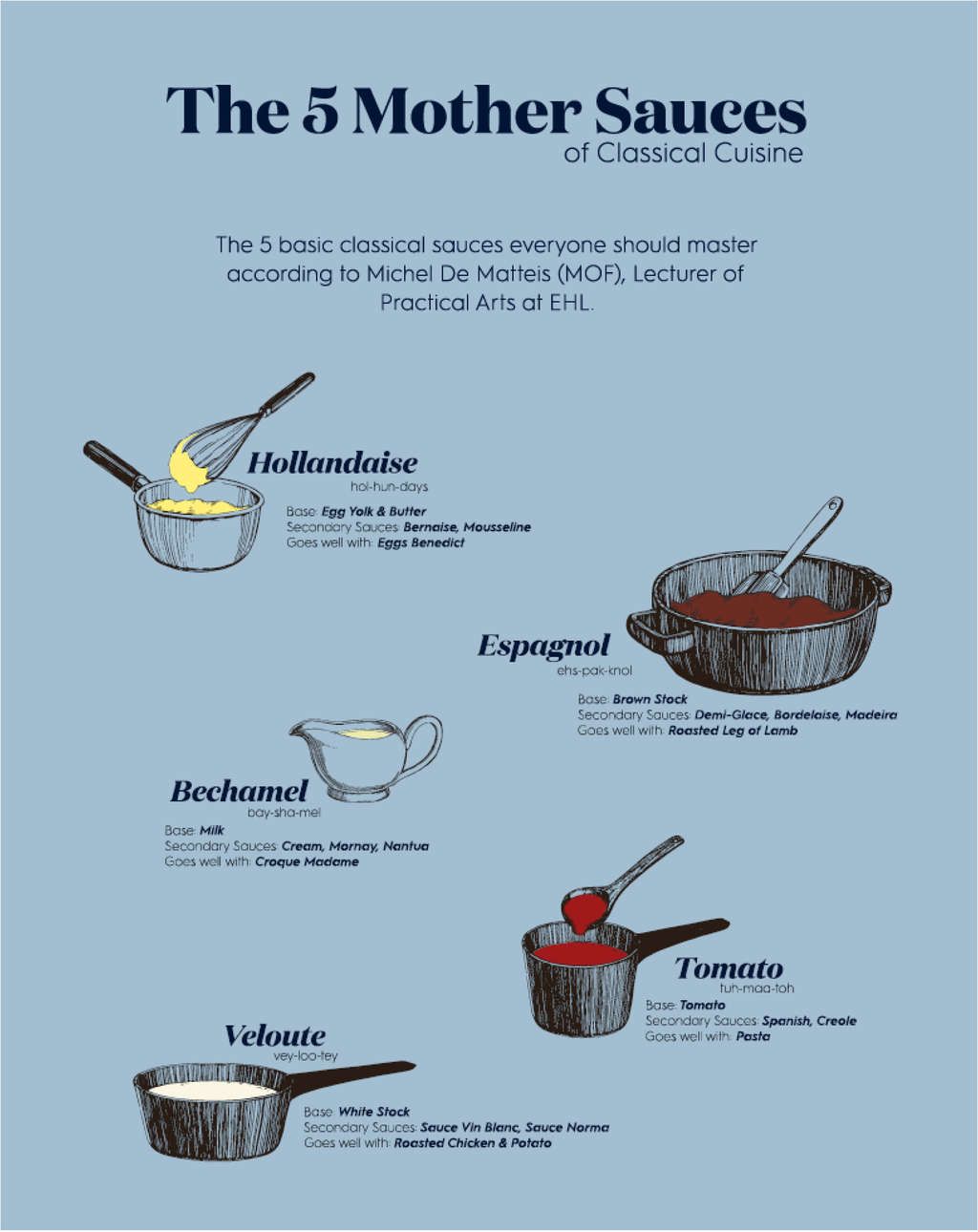What are the 5 mother sauces of classical cuisine?
Authored by Michel De Matteis (MOF), Lecturer of Practical Arts, EHL
The 5 mother sauces, originating from French cuisine, were codified by chef Marie Antoine-Carême in the early 20th century, serving as the foundation for all other sauces. In 1833, Marie Antoine Carême published a classification of French sauces in his reference cookbook L’art de la cuisine française au XIXe siècle ("The Art of French Cuisine in the 19th Century").
Aspiring culinary students should commit these five sauces to memory as the building blocks from which their sauce repertoire will grow. By adjusting their basic formulas, chefs can create hundreds of unique and delicious sauces. In this article, you will learn about each of the 5 mother sauces, their preparation, and usage throughout history.
What are the 5 Mother Sauces?
Discover Antoine-Carême's classificationof the mother sauces below, click on the sauce you're most interested in, read on to explore them all, or jump ahead to our five mother sauces infographic for a speedy recap.
Sauces can be served cold (mayonnaise), lukewarm (pesto), or warm (Béchamel), and can even be savory or sweet (Coulis). At its very basic purpose, sauces should harmonize the flavors of the main ingredients on the plate, as well as their texture and cooking method.
5 Mother Sauces Formula
When Marie Antoine-Carême was creating his classification he discovered that all sauces comprised of the same 3 elements, the formula is as follows:
- a liquid,
- a thickener,
- and seasoning.
A roux is the thickening agent used in four of the mother sauces. To create a classic roux, you must stir equal parts of flour and butter over medium-low heat for three to five minutes for a light roux, six to seven minutes for a brown roux, and up to 15 minutes for a dark roux.
1. Béchamel
You may know béchamel sauce as the white sauce that is used in many dishes, such as chicken pot pie, macaroni and cheese, scalloped potatoes, lasagne, and gravy. In classical cuisine, béchamel can be poured over fish, eggs, or steamed chicken to add a unique creamy texture that often makes food taste hearty and comforting, despite its neutral taste on its own.
To make béchamel, cooks first create a roux by stirring flour into melted butter to form a paste. The paste is then cooked over medium heat for several minutes, which removes the floury taste, before a liquid, most commonly milk, is added. The flour paste thickens the milk to create the versatile creamy white sauce. Salt and pepper may be added, as well as other flavorings including bay, nutmeg, onion, clove, or cheese.
2. Velouté
Velouté means velvet in French, which is the texture you will find with this original mother sauce. To make a velouté, cooks create a roux with butter and flour and add a clear stock to it. Chicken, turkey, and fish stock are most commonly used, but these days, you will also find a vegetarian velouté.
When finished, velouté has a delicate, light flavor and a smooth texture. The sauce is usually served over poached or steamed fish or chicken; the light flavors of the sauce complement the light, delicate meat. By adding wine, lemon, or other flavorings, cooks can adjust the flavor and richness of this mother sauce.
3. Espagnole
This dark brown sauce, one of Carême's original mother sauces, gives that signature richness to boeuf bourguignon, lamb, duck, veal, and other hearty dishes. Espagnole is the basis for demi-glace, sauce Robert, and bordelaise sauce.
Like the other mother sauces, espagnole starts with a roux. In this case, the flour paste is cooked until the flour browns. It's important that cooks stir the roux while it browns so the paste does not scorch.
When the roux has finished cooking, browned mirepoix – which is a mixture of diced celery, carrot, and onion – pureed tomato, and beef or veal stock are added.
4. Sauce Tomate
Sauce tomate, or tomato sauce, bears slight resemblance to the Italian style tomato sauce served with pasta. This mother sauce is often served on top of pastas (especially gnocchi) or polenta, or with grilled meat or vegetables. In Carême's day, sauce tomato was thickened with a roux, but this is no longer the case.
Now, tomatoes are cooked down into a thick sauce that is flavored with vegetables and pork. Roux can thicken the sauce quickly if there's little time. Carême classified sauce tomate as a mother sauce in the early 20th century.
5. Hollandaise
You may recognize Hollandaise sauce from eggs benedict or as a topping for lightly steamed asparagus. The sauce can also accompany richer foods, like meats. Like sauce tomate, this sauce was a later addition to Carême's list.
Hollandaise sauce is an emulsion where egg yolks are suspended in melted butter to create a creamy, rich sauce. Optional flavorings for Hollandaise include cayenne pepper, white wine vinegar, or lemon juice. Hollandaise is the basis for several other classical French sauces, including sauce Bearnaise.
To make Hollandaise, the egg yolk, and melted butter are whisked together carefully to create an emulsion. New cooks often struggle with Hollandaise, because the sauce can break easily, separating out the butter from the egg yolk.
Whether you are interested in culinary school or simply want to pimp up your home cooking by learning about classical cuisine, the 5 mother sauces are a pretty important place to start. By mastering them, you can easily jazz up a weekday supper, create a special occasion meal, or perfect your chef skills.
About EHL Group
EHL Group is the global reference in education, innovation and consulting for the hospitality and service sector.
With expertise dating back to 1893, EHL Group now offers a wide range of leading educational programs from apprenticeships to master's degrees, as well as professional and executive education, on three campuses in Switzerland and Singapore. EHL Group also offers consulting and certification services to companies and learning centers around the world. True to its values and committed to building a sustainable world, EHL Group's purpose is to provide education, services and working environments that are people-centered and open to the world. www.ehlgroup.com
EHL Hospitality Business School
Communications Department
+41 21 785 1354
EHL


